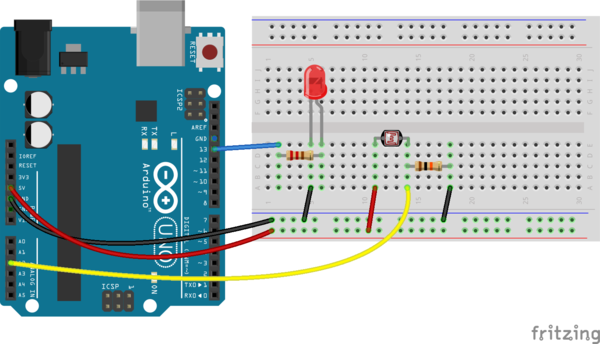Fotowiderstand am Arduino Uno: Unterschied zwischen den Versionen
(new file) |
(→Anschluß eines LDR (Fotowiderstand) an den Arduino) |
||
| Zeile 1: | Zeile 1: | ||
== Anschluß eines LDR (Fotowiderstand) an den Arduino == | == Anschluß eines LDR (Fotowiderstand) an den Arduino == | ||
| − | Für den Anschluss eines Fotowiderstand an den Arduino | + | Für den Anschluss eines Fotowiderstand an den Arduino wird folgendes benötigt: |
| + | |||
| + | * Arduino Board | ||
| + | * [[LDR Fotowiderstand]] | ||
| + | * [[Steckbrett}} | ||
| + | * 10 kOhm [[Widerstand]] | ||
| + | * [[LED Leuchtdiode]] | ||
| + | * 220 Ohm [[Widerstand]]. | ||
[[File:LDR-Arduino_wiring.png|600px|LDR Verdrahtung]] | [[File:LDR-Arduino_wiring.png|600px|LDR Verdrahtung]] | ||
Version vom 19. Februar 2018, 23:20 Uhr
Anschluß eines LDR (Fotowiderstand) an den Arduino
Für den Anschluss eines Fotowiderstand an den Arduino wird folgendes benötigt:
- Arduino Board
- LDR Fotowiderstand
- [[Steckbrett}}
- 10 kOhm Widerstand
- LED Leuchtdiode
- 220 Ohm Widerstand.
Programm für den Arduino
const int ledPin = 13;
const int ldrPin = A0;
void setup() {
Serial.begin(9600);
pinMode(ledPin, OUTPUT);
pinMode(ldrPin, INPUT);
}
void loop() {
int ldrStatus = analogRead(ldrPin);
if (ldrStatus <=300) {
digitalWrite(ledPin, HIGH);
Serial.println("LDR is DARK, LED is ON");
}
else {
digitalWrite(ledPin, LOW);
Serial.println("---------------");
}
}
